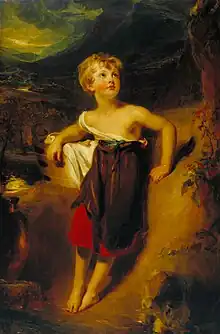Georgiana Fane
Lady Georgiana Fane (1801-1874) was an English heiress, daughter of John Fane, 10th Earl of Westmorland and his second wife the former Jane Huck-Saunders.[1] Her mother bore four other children before separating from her father, after ten years of marriage.
Georgina Fane | |
|---|---|
| Born | 1801 |
| Died | 1874 (aged 72–73) |
| Other names |
|
| Occupation | heiress |
| Known for | her pursuit of the Duke of Wellington |

Georgiana is known for two things, a much commented upon portrait of her, when she was five or six years old, dressed as a peasant girl, and for her apparent stalking of the Duke of Wellington.[1][2]
She met Wellington in 1815, shortly after his final victory over Napoleon Bonaparte, at the Battle of Waterloo, when she was fourteen years old, and he was 47.[1]
Lord Palmerston, who was carrying on an affair with her married half-sister, Sarah Villiers, Countess of Jersey, proposed to Georgiana, twice, in 1823, but she turned him down.[3]
The existence of suggestive letters, from Wellington, seems to confirm they did have a sexual relationship in the 1820s.[1][2][4] After his wife, the former Kitty Pakenham, died in 1830, Georgiana, and several other women intensified their interest in Wellington, hoping to become his second wife. She could not accept his rejection of her, and harassed him for the rest of his life.
In 1846 she was sculpted by John Edward Carew.[5]
References
- Catherine Miller; John Vincent (2 July 2002). "Wellington's lost battle with stalker". The Telegraph. Retrieved 6 August 2018.
- "The female stalker who put the boot into Wellington". Herald Scotland. 27 July 2002. Retrieved 21 May 2020.
- Denis Judd (2015). Palmerston. Bloomsbury Publishing. ISBN 9780857725738.
-
Toni Ford (2 October 2015). "Great British Houses: Brympton D'Evercy = a stunning stately home in Somerset".
The house was largely empty until John 10th Earl of Westmorland's wife Jane Saunders and her daughter Lady Georgina Fane took up residence. That these ladies lived independently of the Earl was scandalizing enough, but Lady Georgiana's affair with the Duke of Wellington is what really got society talking. The affair never became a marriage and Lady Georgiana lived on at Brympton d'Evercy alone following her mother's death.
- Dictionary of British Sculptors 1660-1851 by Rupert Gunnis